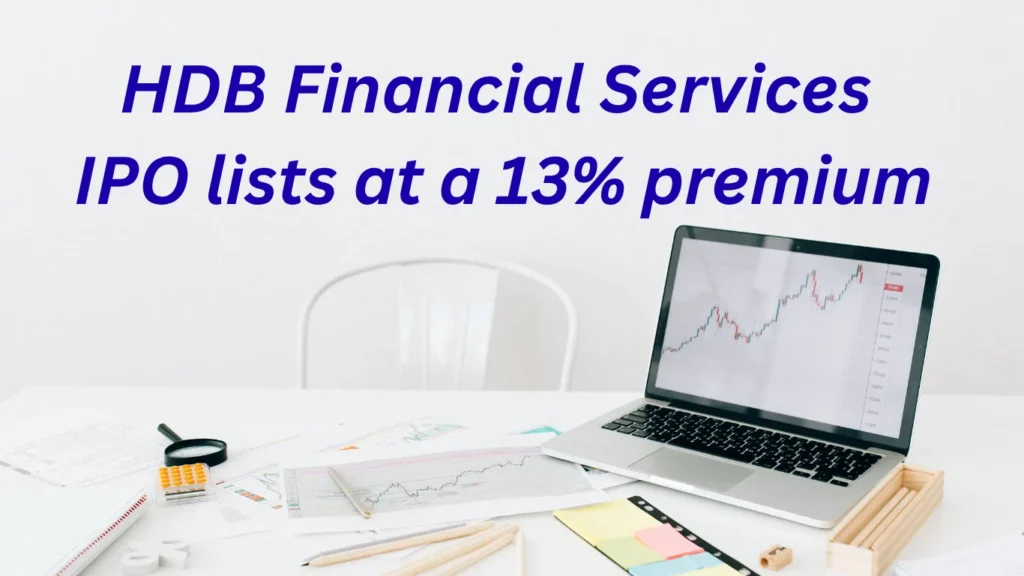
HDB Financial Services IPO Listing: A Powerful Debut on Dalal Street
HDB Financial Services made a commanding entry into the stock market on July 2, 2025, listing at ₹835 per share — a 13% premium over the issue price of ₹740. The company’s listing has instantly elevated it to the 8th largest NBFC (Non-Banking Financial Company) in India by market capitalisation, now hovering around ₹70,000 crore.
IPO Highlights: India’s Largest-Ever NBFC Issue
- IPO Size: ₹12,500 crore
- Fresh Issue: 3.38 crore shares worth ₹2,500 crore
- Offer for Sale (OFS): 13.51 crore shares aggregating ₹10,000 crore
- Anchor Investor Contribution: ₹3,369 crore
- IPO Subscription: Over ₹1.61 lakh crore in bids — one of the most subscribed issues in the ₹10,000+ crore category, trailing only Tata Technologies and Bajaj Housing Finance
Listing Day Performance: Modest Gains Post Premium Start
After listing at ₹835, HDB Financial shares ended the day with minor gains:
- BSE Close: ₹840.90 (+0.71%)
- NSE Close: ₹840.25 (+0.63%)
Intraday, the stock touched highs of nearly ₹849, reflecting investor confidence and solid demand across retail and institutional segments.
What Makes HDB Financial Services Stand Out?
Backed by HDFC Bank, India’s largest private sector bank, HDB Financial is classified as an upper-layer NBFC by the RBI. As of March 2025:
- Assets Under Management (AUM): ₹1,07,300 crore
- Gross Loan Book: ₹98,620 crore
- Net Profit (FY24): ₹2,460.8 crore
- Return on Assets (ROA): 3.03%
- Return on Equity (ROE): 19.55%
- Gross NPAs: 1.90%
- Net NPAs: 0.63%
The company has built a strong hybrid distribution network with over 1,770 branches in 31 states and union territories, serving over 1,170 towns and cities.
Key Business Verticals
HDB Financial operates three main lending divisions:
- Enterprise Lending: Targeting small businesses with secured/unsecured loans.
- Asset Finance: Offering loans for commercial vehicles, tractors, and equipment.
- Consumer Finance: Providing quick loans for electronics, two-wheelers, and personal needs.
Market Analysts React
Mehta Equities:
“Listing met expectations. The overwhelming response reflects market trust in HDB’s parentage and growth model,” said Prashanth Tapse, SVP of Research.
Bajaj Broking:
HDB’s AUM has grown 22–29% YoY, though rising NPAs and provisioning have pressured margins. Its vast network and diversified portfolio remain major strengths.
Anand Rathi:
HDB is focused on optimizing its lender base to reduce borrowing costs and improve leverage efficiency.
Deven Choksey Research:
The firm has delivered a 23.7% CAGR in AUM and a 12.9% CAGR in PPoP over FY23–25. Analysts see strong future disbursement growth, especially in urban and rural consumption segments.
Emkay Global:
Initiated coverage with a ‘Buy’ rating and ₹900 target, citing HDB’s solid fundamentals and expected 20% AUM CAGR and 27% EPS CAGR from FY25 to FY28.
HDB’s Position Among NBFC Giants
With its debut, HDB Financial has joined India’s leading NBFCs:
| NBFC | Market Cap (approx.) |
|---|---|
| Bajaj Finance | ₹5.81 lakh crore |
| Jio Financial | ₹2.08 lakh crore |
| Cholamandalam | ₹1.37 lakh crore |
| HDB Financial | ₹70,000 crore |
| Shriram Finance, Muthoot, SBI Cards, Aditya Birla Capital | ₹72,000 – ₹1.33 lakh crore |
Grey Market Sentiment & GMP Movement
Ahead of its listing, Grey Market Premium (GMP) for HDB Financial rose to ₹68, implying an estimated listing price around ₹808. The final listing price of ₹835 exceeded expectations, further reinforcing bullish sentiment.
Regulatory Watch: RBI May Trigger Ownership Changes
Emkay noted that the RBI’s October 2024 draft circular may compel HDFC Bank to reduce its stake in HDB if the regulation disallows overlapping businesses within subsidiaries. This remains a potential medium-term factor to watch.
Final Take: Should You Hold, Buy More, or Book Profits?
HDB Financial Services has had a strong yet measured debut, indicating steady investor confidence rather than frenzied hype. Backed by robust fundamentals, a trusted promoter, and a diversified product line, the company is well-positioned for long-term value creation.
If you’re a long-term investor, holding or accumulating on dips could be a wise strategy. Those seeking quick profits may consider booking partial gains.
Disclaimer:
The content in this article is for informational purposes only and does not constitute financial advice or a recommendation to buy, sell, or hold any securities. Stock market investments are subject to market risks. Readers are advised to consult with a certified financial advisor or conduct their own research before making any investment decisions. The author and publisher are not liable for any losses or damages arising directly or indirectly from the use of this information.